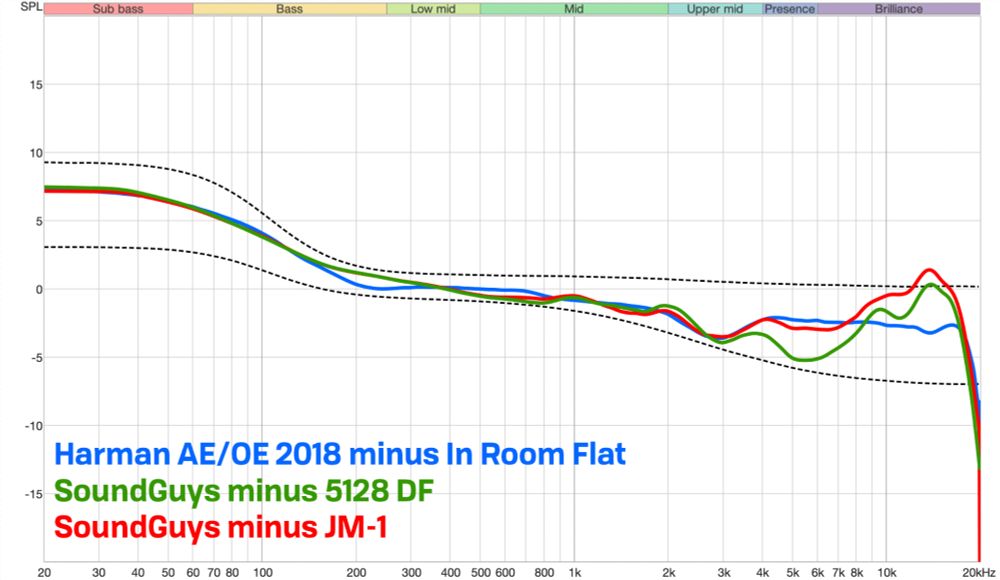Arya Unveiled is $1450, but they just released the Ananda Unveiled which is going to be the cheapest in their lineup with this "extremely open" approach to acoustic design ($550), so it may be worth waiting to see if that exhibits the same behavior & if so get that one instead. I'll keep you posted!
01.10.2025 14:38 — 👍 2 🔁 0 💬 1 📌 0

Very interesting, can say it looks quite a bit different than our results for the unveiled versions. Attached is data for the Arya Unveiled. The HE1000 and Susvara Unveiled both show similarly small difference in the part of the headphone response dominated by pressure effects <3 kHz (~1dB max).
30.09.2025 22:22 — 👍 0 🔁 0 💬 2 📌 0
Ahhh I see, thanks for sharing, this makes it very clear how it was done.
30.09.2025 22:19 — 👍 0 🔁 0 💬 0 📌 0
Got it!
30.09.2025 22:18 — 👍 0 🔁 0 💬 0 📌 0
It’s possible I’d opt for one of the Unveiled Hifiman headphones (AryaUV/HE1000UV/SusvaraUV) considering they’ve exhibited the least variation between Type 3.3 and 4.3 systems in our limited testing, but it’d have to be a unit that didn’t have the commonly-occuring THD issues around @ 4kHz/QC issues
30.09.2025 20:22 — 👍 0 🔁 0 💬 1 📌 0
Its tough, because for all of its benefits the HD 800 still has reasonably high variation depending on how its worn, and most electrostats aren’t exceedingly well designed such that many have unintentional leaks in the front volume that change with clamp force (subject head width). 1/2
30.09.2025 20:18 — 👍 0 🔁 0 💬 0 📌 0
Interesting. Was the metric tested “similarity,” or “similarity of preference”? I could see the former being a little harder/noisier to test than the latter.
30.09.2025 20:17 — 👍 0 🔁 0 💬 2 📌 0
Was the replicator headphone for this sufficiently placement/ear load invariant? Very excited for this but I confess I'm really hoping you didn't only use Dan's headphones for the replicator duties 😅
27.09.2025 23:32 — 👍 1 🔁 0 💬 1 📌 0
Just gave it a pass. Very interesting indeed. Wish I was going to the conference so I could be there for the discussion.
23.08.2025 22:22 — 👍 0 🔁 0 💬 0 📌 0
Love my SSL 2+ except that the Phones A output has nasty channel imbalance. Love that there’s no BS software to deal with though.
07.02.2025 04:44 — 👍 2 🔁 0 💬 0 📌 0
See ya there, big dawg!
07.02.2025 04:40 — 👍 0 🔁 0 💬 0 📌 0
YouTube video by The Headphone Show
The Noise Floor — The DARK SIDE of Audio w/ Resolve, GoldenSound, Mad_Economist, & listener
Come hang! www.youtube.com/watch?v=7Vy4...
25.01.2025 18:01 — 👍 7 🔁 0 💬 0 📌 0
Any chance the HATS was a KEMAR with the Welti pinna? Your blocked canal measurements of headphones on humans + measurement fixtures showed good parity between it and humans iirc.
On that note, is there any chance you’ve done anything like a DF / SRF measurement of a KEMAR with the Welti pinna?
19.12.2024 21:45 — 👍 0 🔁 0 💬 1 📌 0
@resolvereviews.bsky.social has a video coming on them this week!
19.12.2024 05:38 — 👍 1 🔁 0 💬 1 📌 0
The latter I think would only work with a small sample size if you had access to a few of the same subjects from eg. the 2013 or 2015 papers though, so might be more pragmatic to do the other one :) 3/3
19.12.2024 04:11 — 👍 0 🔁 0 💬 0 📌 0
But if it was up to me, I’d be asking you to do listening tests for OE headphones based on similar human measurements (DF HRTFs + HpTFs at the blocked canal) but testing how the LS/HS adjustments would deviate from 2013/2015 when individual HRTF is compensated for 2/?
19.12.2024 04:08 — 👍 1 🔁 0 💬 1 📌 0
For CanJam audience I’d do “Does personalized EQ based on listener HRTF correlate to reports of ‘technicalities’?”
Can measure DF HRTFs + HpTFs for a few people at the blocked ear&do listening tests with an HD 800S and see which profile—stock or personalized—has more reported soundstage/detail 1/?
19.12.2024 04:02 — 👍 2 🔁 0 💬 2 📌 0
Ah okay that makes a lot more sense. Waaaay easier to avoid dealing with anything past the canal entrance 😂
& no kidding! Hats off to that engineer of yours.
16.12.2024 04:46 — 👍 0 🔁 0 💬 1 📌 0
Looks like very clean work. Done in 00 35 silicone, I assume?
I also assume you’re terminating this in a 711 coupler (or perhaps the ear sim from the HMS type 4.4 system), where did you decide to terminate the canal/place the microphone?
16.12.2024 03:25 — 👍 0 🔁 0 💬 1 📌 0
are those custom pinnae?
16.12.2024 03:17 — 👍 0 🔁 0 💬 1 📌 0
YouTube video by The Headphone Show
The Noise Floor — Headphones WE Recommend At Each Price Tier w/ Resolve, Mad_Economist & listener
www.youtube.com/watch?v=2jQJ... Come hang!
07.12.2024 19:35 — 👍 3 🔁 0 💬 1 📌 0
It is:
Harman AE/OE 2018
- Harman In-Room Flat
________________________
That curve
05.12.2024 01:31 — 👍 2 🔁 0 💬 0 📌 0
I said this forgetting we have the 10dB slope 😓
Trust that the caveats I mentioned re: acoustic load interactions confounding confidence applies equally to this line 😅
05.12.2024 00:24 — 👍 0 🔁 0 💬 0 📌 0
However, the same caveats discussed in other parts of this thread still apply; the relevance and predictive power of the bounds as well as either of the DF baselines are still limited by unknowns (ear load and IEM load). For these reasons I tend to advise more caution interpreting IEM measurements.
05.12.2024 00:06 — 👍 0 🔁 0 💬 0 📌 0
If we did adopt some sort of target line—we're not, but if we did—we'd want it to be something performant in preference research. SoundGuys being so close to our chosen HRTF with prior well-performing adjustments does give us some confidence that the JM-1 DF as compensation baseline has merit. 2/?
05.12.2024 00:00 — 👍 0 🔁 0 💬 2 📌 0

As Andrew said, we don't have OE/IEM targets.
Considering how well SoundGuys has been testing, it seems a nice coincidence that using JM-1 (DF) as our IEM compensation baseline (not a target) makes SoundGuys damn near identical to the well-preferred Harman AE/OE 2018 target under 8 kHz, no? :)
1/?
04.12.2024 23:55 — 👍 0 🔁 0 💬 3 📌 0
However this is also why I think re: IEM preference testing, multiple replicators (or a single replicator with mutable acoustic parameters eg. modular venting) would likely be of interest to gauge how preference and/or in-situ response change with loading even if FR on eg. 4620 is constant 4/4
04.12.2024 05:04 — 👍 1 🔁 0 💬 1 📌 0
DF calibration on its own surely doesn’t solve this, & indeed one of the alluring parts of testing for preference is that you account for these impedance interactions by not accounting for them; acoustic impedance’s effects are in the results even if they’re not a separately controlled variable 3/?
04.12.2024 05:00 — 👍 2 🔁 0 💬 2 📌 0
I’m personally more interested to see IEM studies based on measurements done in human ear canals, because everything seems to indicate that the averages behind the 1/2 middle ear simulators we use to measure IEMs isn’t enough to represent the typical acoustic impedance deviation across listeners 2/?
04.12.2024 04:57 — 👍 1 🔁 0 💬 2 📌 0
Finally getting to this. Re: point 1, that’s partially why we’ve adopted a DF HRTF that’s a little less specific to the rig’s outer ear effects while still using the canal/eardrum components of the 4620 as our chosen DF for IEMs. However, as you say, acoustic impedance is a massive problem here. 1/?
04.12.2024 04:35 — 👍 1 🔁 0 💬 1 📌 0
Horizon 2020 project using AI to revolutionise immersive audio for augmented and virtual reality.
I worship Satan and listen to music.
https://linktr.ee/dielawnscarz
Audio metrology, headphones, terrible takes
•YouTube
•Audio science, Tech, & DIY nerd
•Right to repair advocate
https://www.youtube.com/dms3tv
https://floatplane.com/channel/DMS3/
https://dmstech.store
i am a former Senior Fellow at Harman doing research in perception and measurement of sound quality including loudspeakers and headphones. Interests include music, hockey, wine, cycling, politics, science and technology. A Canadian who is also American.
I talk about headphone things.
https://www.youtube.com/@TheHEADPHONEShow
https://www.youtube.com/@ResolveReviews
Audio and technology enthusiast. "GoldenSound" on youtube, https://goldensound.audio and "The Headphone Show" on youtube
#Ho3K 🌃 | Loves @momoch0.bsky.social 💕 | real bonk | I am pretty good at Pokémon | I like to talk about coffee ☕ & headphones 🎧 | Chess enjoyer♟️| Always looking up 🌌 | Profile pic by https://feenisticks.carrd.co/ | he/him
The Original American Stereophone Company #HearingIsBelieving
www.koss.com



